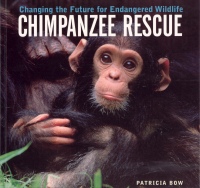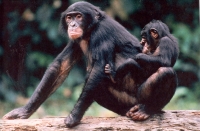| ________________
CM . . .
. Volume XI Number 11 . . . .February 4, 2005
excerpt: The chimpanzees of the Bossou Hills in Guinea, West Africa, are living in a slowly shrinking prison. No new chimps have come to this community in more than 20 years. Without new blood, fewer healthy babies will be born, and the population's chances of survival will plummet. But not if Tetsuro Matsuzawa can help it. Matsuzawa is a primatologist - a scientist who studies primates - from Kyoto University in Japan, and he leads a field study that began at Bossou in 1976. These chimps belong to the western subspecies (Pan troglodytes verus) which now number fewer than 25,000. The small group at Bossou - of which no more than 20 remain -became famous in the early 1980s when scientists discovered they use stone tools to crack oil-palm nuts. Just two and a half miles from Bossou lie the Nimba Mountains, home to about 250 chimpanzees. But the Bossou chimpanzees have never been known to cross the open grassland. Matsuzawa's plan was to extend the forest all the way to Nimba. Chimpanzees are probably the most recognized of the apes, having been one of the traditional media and circus performers in past decades. That began to change when Jane Goodall told the scientific world in the 1960s of her observations of chimp behavior. Once it became known that we share 98% of their DNA and that the population of chimpanzees worldwide was in steep decline (they were declared endangered in 1988), conservation groups pushed for their protection. Part of the "Firefly Animal Rescue" series, this highly readable book will alert young readers to the current status of chimps in a world of disappearing habitat, poaching and disease, to the work being done to save or rebuild remaining populations and to new laws designed to protect them.
In several profiles and accounts of research projects, the author details the current work of scientists who are trying to find ways to preserve and protect this endangered animal. Underlying all of their efforts is the wish to promote respect for this mammal that is our closest relative in the animal kingdom. For young readers with a passion for animals, the information in this book may inspire future careers, or at least a desire to support projects designed to protect endangered species. The list of conservation organizations at the back of the book is a place to start further investigation. Excellent color photographs help to extend reader understanding. One can't read this book without admiring the dedication of those people working to save another creature on the brink of extinction. Highly Recommended. A freelance writer and former teacher-librarian, Gillian Richardson lives in BC.
To comment
on this title or this review, send mail to cm@umanitoba.ca.
Copyright © the Manitoba Library Association. Reproduction for personal
use is permitted only if this copyright notice is maintained. Any
other reproduction is prohibited without permission.
NEXT REVIEW |
TABLE OF CONTENTS FOR THIS ISSUE
- February 4, 2005.
AUTHORS |
TITLES |
MEDIA REVIEWS |
PROFILES |
BACK ISSUES |
SEARCH |
CMARCHIVE |
HOME |

 Since chimps are mostly arboreal, the destruction of rain forests across the tropical belt of their
central African home has drastically reduced available habitat. The rescue project mentioned in the
excerpt above is one attempt to address this deficiency by replanting clusters of trees across open
savanna, with hopes of providing a corridor to link isolated chimp communities. With increasingly
less space between human and chimp populations, conflicts are frequent, and the chimps are
regularly hunted for 'bushmeat', which fetches a high price. The discovery that chimps could be
infected with human diseases, such as HIV, led to many being captured for medical research.
Since chimps are mostly arboreal, the destruction of rain forests across the tropical belt of their
central African home has drastically reduced available habitat. The rescue project mentioned in the
excerpt above is one attempt to address this deficiency by replanting clusters of trees across open
savanna, with hopes of providing a corridor to link isolated chimp communities. With increasingly
less space between human and chimp populations, conflicts are frequent, and the chimps are
regularly hunted for 'bushmeat', which fetches a high price. The discovery that chimps could be
infected with human diseases, such as HIV, led to many being captured for medical research.